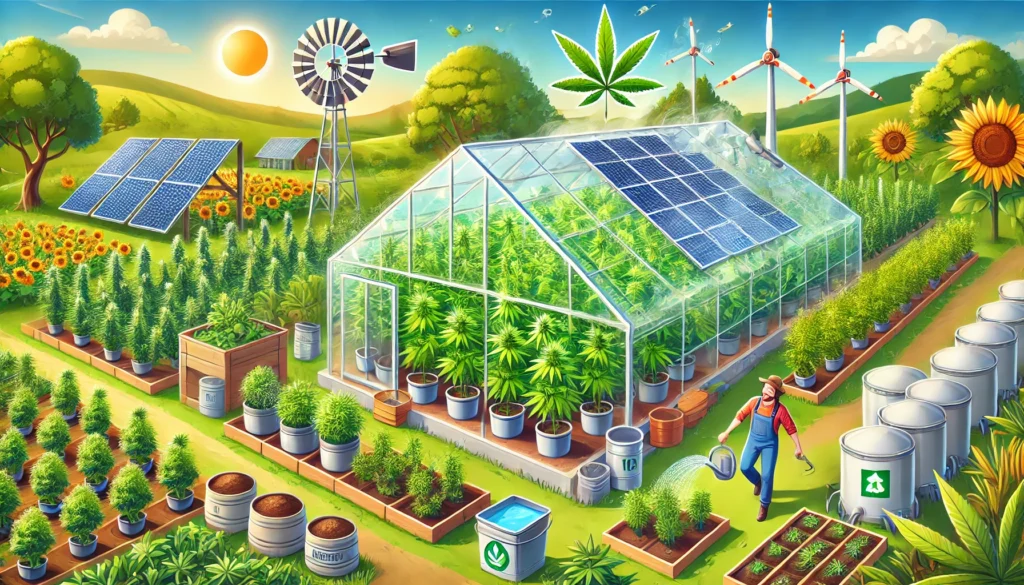Energy-Efficient Techniques for Greenhouse Growing
Sustainable medicinal cannabis cultivation practices and procedures in a greenhouse is like having a natural partner in your cultivation journey. With the right tweaks, you can reduce energy costs and make your operation greener—literally and figuratively. Let’s explore some energy-efficient tips to get the most out of your greenhouse setup while keeping the planet happy.
Maximizing Natural Light: Let the Sunshine In
Your greenhouse’s best feature is its ability to harness natural sunlight. Take full advantage by positioning your structure to maximize exposure. Ideally, aim for an east-west orientation, so your plants soak up sunlight all day. Clean those panels regularly; dust and grime can block light, reducing its effectiveness. You don’t want your cannabis flowers working harder just because of a dirty roof, right?
Using diffused glazing materials for your greenhouse is another clever move. These materials scatter sunlight evenly, preventing harsh shadows and hot spots that can stress your plants. Bonus: It saves energy otherwise spent on artificial lighting. And when the seasons change, install reflective curtains or screens to bounce more light onto your plants. They’ll thank you with lush growth and higher yields.
Smart Heating and Cooling: A Win for Your Wallet
Temperature control in a greenhouse can be tricky, but it doesn’t have to drain your energy budget. Passive solar heating is a game-changer. By adding thermal mass materials—like water barrels or concrete floors—you can store heat during the day and release it at night. This keeps temperatures stable without constant reliance on heaters.
When it comes to cooling, ventilation is your secret weapon. Install vents and exhaust fans to keep air circulating naturally. Combine this with shade cloths to reduce heat buildup during scorching afternoons. You’d be surprised how much energy you save by letting the wind and shade do their thing!
Don’t forget about energy-efficient fans and heaters if you need mechanical help. Invest in models with smart thermostats that automatically adjust to your preferred range. It’s like having a digital assistant for your cannabis babies.
Efficient Irrigation: Water Smarter, Not Harder
Believe it or not, water systems play a role in energy efficiency. Drip irrigation is your greenhouse’s best friend—it delivers water directly to your plant roots, minimizing waste. This not only saves water but also reduces the energy needed for pumping.
For an extra green boost, recycle rainwater. Set up collection systems and use it for irrigation. You’ll cut down on municipal water use and help your plants thrive with chemical-free hydration. Plus, your wallet will thank you for avoiding hefty water bills.
Pair your irrigation system with timers and moisture sensors to keep things running smoothly. These gadgets ensure you’re not overwatering or underfeeding your plants. The result? Happy cannabis flowers and a more energy-efficient setup.
Insulate Like a Pro
Insulation might not sound glamorous, but it’s a superhero for energy savings. Use materials like bubble wrap or polycarbonate sheets to seal your greenhouse. They trap heat while still letting light in, reducing the need for constant heating during colder months.
For the floor, add an insulating layer of gravel or mulch. This prevents heat from escaping into the ground and keeps your greenhouse cozy. Think of it as giving your cannabis plants a warm blanket when temperatures dip.
To avoid heat loss at night, consider thermal curtains. These roll down after sundown to keep the warmth in and the cold out. They’re simple to install and can drastically cut energy use.
The Future Is in Automation
Energy efficiency doesn’t have to mean micromanaging every detail. Automation tools are here to save you time and effort. Install a climate control system that monitors light, temperature, and humidity levels, adjusting settings as needed. It’s like hiring a round-the-clock caretaker for your greenhouse.
Smart lighting systems are another must-have. They turn lights on and off based on sunlight levels, ensuring you’re not wasting electricity. You’ll also find systems that integrate with your irrigation setup, delivering the perfect amount of water without lifting a finger.
Small Changes, Big Impact
Adopting energy-efficient techniques doesn’t just save money—it’s a step toward sustainable cannabis cultivation. Even small adjustments, like cleaning your panels or adding shade cloths, can make a big difference. You’ll reduce your carbon footprint, grow healthier plants, and set your greenhouse up for long-term success.
So, take it one step at a time. Experiment with these methods, track your energy savings, and watch your cannabis flowers thrive. Your wallet, your plants, and the planet will all thank you for the effort!
Water Conservation Strategies in Cannabis Cultivation
Water is life—not just for us but for your precious cannabis plants, too. But let’s face it, water isn’t infinite, and with cultivation scaling up globally, it’s time to get smart about conserving it. Don’t worry, saving water doesn’t mean sacrificing the quality of your grow. With a few savvy strategies, you can cut waste, reduce costs, and keep your plants thriving.
Efficient Irrigation: Less Splash, More Growth
If you’re still using the old-school method of flooding your plants with water, it’s time for an upgrade. Drip irrigation is the modern cultivator’s best friend. This system delivers water directly to the roots of each plant, avoiding evaporation and runoff. It’s like giving your plants their very own water bottle, sip by sip, without any spillage.
Another game-changer? Timers and moisture sensors. These nifty tools let you water your cannabis exactly when and how much they need it. You’ll stop second-guessing yourself and ensure no drop goes to waste. Plus, overwatering becomes a thing of the past—your plants won’t drown, and you’ll save gallons.
For larger setups, consider automated irrigation systems. These let you sit back while technology ensures every plant gets the right amount of water. It’s efficient, stress-free, and gives you more time to admire your beautiful flowers.
Rainwater Harvesting: Nature’s Free Gift
Why pay for water when Mother Nature offers it for free? Rainwater harvesting is an eco-friendly and cost-effective solution. All you need are a few collection barrels or a more advanced rainwater system, and you’re in business. It’s like building a personal water bank that your plants can tap into whenever they’re thirsty.
Rainwater isn’t just free—it’s also free from chemicals often found in municipal water, like chlorine. This makes it a pure and gentle option for your cannabis plants. Remember to install a basic filter to keep out leaves, dirt, and other debris. Your plants deserve clean hydration, after all.
This strategy works wonders in rainy regions but can still benefit growers in drier climates. Even a few rainy days a year can fill your barrels and cut your water bill. Every drop counts, right?
Recycling Water: Don’t Let It Go to Waste
Ever thought about giving your water a second life? Recycling water is a smart way to conserve resources and save money. With a closed-loop system, you can collect runoff water, filter it, and reuse it for your plants. It’s like a boomerang—you use it, clean it, and send it back to work.
Filtration systems are key here. Invest in a good one that removes salts, nutrients, and contaminants from the runoff. This ensures your recycled water is clean and safe for your cannabis. Some systems even let you monitor nutrient levels, so you’re not just recycling water—you’re also optimizing plant health.
Another idea? Greywater systems. These systems recycle water from non-polluted sources like washing machines or sinks (as long as no harmful chemicals are involved). With the right setup, you can turn your used household water into a goldmine for your plants.
Mulching: The Unsung Hero of Water Retention
Mulch isn’t just for flower beds—it’s a secret weapon for cannabis cultivation, too. By adding a layer of mulch around your plants, you can reduce evaporation and keep the soil moist for longer. It’s like giving your plants a cool, protective blanket in the hot sun.
Organic mulches like straw, wood chips, or shredded leaves work wonders. They not only retain water but also improve soil health as they break down. It’s a win-win for your plants and the environment. And let’s be honest, who doesn’t love a solution that’s low effort but high reward?
If you’re growing indoors or using pots, mulch still has your back. It keeps the topsoil from drying out and helps maintain consistent moisture levels. Your cannabis roots will thank you for the steady hydration.
Smart Watering Schedules: Timing Is Everything
When it comes to watering, timing can make all the difference. Watering early in the morning or late in the evening minimizes evaporation. The cooler temperatures during these times mean more water goes to your plants and less disappears into thin air.
Another tip? Water deeply but less frequently. Shallow watering encourages weak roots, while deep watering helps roots grow strong and deep. Strong roots equal strong plants—and isn’t that the goal?
If you’re cultivating outdoors, watch the weather. Skip watering on rainy days and adjust your schedule during dry spells. A little attention to detail goes a long way in conserving water.
Every Drop Counts
Water conservation isn’t just about saving the planet—it’s about working smarter, not harder, to grow top-notch cannabis. By adopting efficient irrigation systems, recycling water, harvesting rain, and timing your watering just right, you’ll reduce waste and boost your yield.
So, next time you turn on the tap, remember: every drop counts. Make the most of it, and your plants—and your wallet—will thank you!
How Organic Growing Enhances Medicinal Value
Growing cannabis organically isn’t just a trend—it’s a revolution that puts nature back in the driver’s seat. Organic methods not only help the environment but also result in cleaner, more potent medicinal cannabis. Let’s dive into why going organic is a game-changer for the health of your plants, your patients, and the planet.
Pure Cannabis, Pure Medicine
When you grow cannabis organically, you’re giving patients something they can truly trust—medicine free from harmful chemicals. Synthetic fertilizers and pesticides may boost short-term yields, but they leave behind residues that can compromise the medicinal value of your plants. You wouldn’t want to ingest something grown with chemicals, so why should your cannabis be any different?
Organic cultivation uses natural fertilizers like compost, worm castings, and bone meal. These not only nourish your plants but also enrich the soil, creating a healthier environment for long-term growth. The result? A cleaner, safer product with no hidden nasties, perfect for patients seeking natural remedies.
Let’s not forget about the taste and aroma. Organic cannabis often has a richer terpene profile, meaning more pronounced flavors and scents. Those terpenes don’t just smell amazing—they enhance the therapeutic effects of cannabis through the entourage effect.
Stronger Plants, Better Medicine
Plants grown organically tend to be healthier and more resilient. Why? Because organic methods focus on building strong root systems and thriving soil ecosystems. Healthy plants are better at producing cannabinoids and terpenes, the compounds responsible for cannabis’s medicinal properties.
Take soil, for example. Organic practices turn dirt into a living, breathing ecosystem full of beneficial microbes. These tiny helpers break down organic matter, making nutrients easily available to your plants. When your soil is alive and kicking, your plants can grow stronger and produce higher-quality medicine.
Even pest control is smarter in organic growing. Instead of chemical sprays, you use natural solutions like neem oil, ladybugs, or companion planting. This keeps your plants safe without introducing toxins, ensuring that your medicinal cannabis stays as pure and potent as nature intended.
The Environmental Bonus
Growing cannabis organically isn’t just better for your plants; it’s also kinder to the planet. Conventional farming practices can deplete soil, pollute water, and harm local ecosystems. Organic growing flips the script by working with nature instead of against it.
Composting is a perfect example. By reusing plant waste, you’re reducing landfill contributions and creating a nutrient-rich fertilizer. It’s a win-win for your garden and the environment. Plus, using renewable resources like rainwater and natural pest controls reduces your ecological footprint.
Think about carbon emissions, too. Organic farming requires less energy-intensive inputs like synthetic fertilizers, which take a lot of energy to produce. When you go organic, you’re helping combat climate change, one plant at a time.
Boosting the Entourage Effect
Ever heard of the entourage effect? It’s the idea that cannabinoids, terpenes, and other compounds in cannabis work better together. Growing organically can amplify this effect by encouraging a diverse and robust chemical profile in your plants.
Synthetic nutrients often prioritize fast growth over complex cannabinoid and terpene production. Organic methods, on the other hand, give your plants the time and nutrients they need to fully develop their medicinal potential. This means your final product isn’t just potent—it’s perfectly balanced.
Patients who rely on cannabis for relief from conditions like chronic pain, anxiety, or inflammation often report better results with organically grown products. The fuller spectrum of compounds makes the medicine more effective, offering a broader range of benefits.
A Healthier Choice for Everyone
At the end of the day, organic growing benefits everyone—cultivators, patients, and the planet. For growers, it means working with nature to produce high-quality cannabis that stands out in a competitive market. For patients, it means cleaner medicine with enhanced therapeutic effects. And for the earth? It’s a much-needed break from the strain of conventional farming.
If you haven’t tried organic growing yet, it’s time to make the switch. Not only will your plants thank you, but so will your customers. After all, when it comes to medicinal cannabis, quality is everything—and nothing says quality like organic.
So, roll up your sleeves, mix that compost, and let nature do what it does best. Your plants—and your patients—will reap the rewards!
Reducing Carbon Footprints in Cannabis Operations
Cannabis might be green, but the industry still has room to grow when it comes to being eco-friendly. With energy-intensive cultivation methods and resource-heavy practices, it’s essential to find ways to reduce your carbon footprint without compromising quality. The good news? There are plenty of smart, simple changes you can make to shrink your environmental impact while still producing top-notch cannabis.
Energy-Efficient Cultivation: Smarter, Not Harder
Let’s face it: growing cannabis can be energy-hungry, especially if you’re using indoor setups with powerful lights. But don’t worry—you can cut down on energy use without cutting corners. Start by swapping out those old, energy-guzzling HID lights for modern LED grow lights. Not only do they consume less electricity, but they also run cooler, which means less work for your cooling systems.
Speaking of cooling, optimizing your HVAC system can make a big difference. Regular maintenance and upgrading to energy-efficient units will help keep your operation running smoothly without burning extra energy. Plus, good insulation in your grow space helps maintain temperature control, reducing the need for constant heating or cooling.
And if you’re lucky enough to use a greenhouse, make the most of natural sunlight. Position your structure to maximize exposure, and consider installing solar panels to power your fans, pumps, and lights. Imagine harnessing the power of the sun to grow your cannabis and run your operation—how cool is that?
Water Conservation = Carbon Savings
You might not realize it, but conserving water is also a great way to reduce your carbon footprint. Pumping, treating, and transporting water requires energy, so using less water can save more than just the planet—it saves energy, too!
Drip irrigation systems are a fantastic start. These systems deliver water directly to your plants’ roots, minimizing waste and energy use. Pair this with rainwater harvesting, and you’re not only cutting down on municipal water use but also reducing the energy needed to supply it.
Closed-loop systems take water conservation a step further by recycling runoff water back into your operation. It’s like creating your very own sustainable water cycle. Add in moisture sensors to avoid overwatering, and you’ve got an eco-friendly watering routine that your plants—and the planet—will love.
Say No to Waste: Reduce, Reuse, Recycle
Cannabis cultivation generates waste, but it doesn’t have to end up in a landfill. From plant material to packaging, there are plenty of ways to reduce, reuse, and recycle. Start by composting plant waste. Leaves, stems, and other organic materials can be turned into rich compost, which improves soil health and reduces the need for synthetic fertilizers.
Speaking of packaging, ditch single-use plastics whenever possible. Opt for biodegradable or reusable packaging materials for your products. Not only will this help the environment, but it’s also a great selling point for eco-conscious customers.
Recycling goes beyond just bottles and cans—think bigger! Reuse growing mediums like soil or coco coir by sterilizing them for future use. Even your cultivation equipment, like old trays or pots, can often find a second life with a bit of creativity.
Transportation: Go Local and Go Green
Shipping cannabis products across long distances has a significant carbon cost, thanks to fuel emissions. One way to reduce this is by focusing on local markets. Selling closer to home not only reduces transportation needs but also strengthens your connection with local customers.
For longer hauls, look into green logistics options. Some companies now offer carbon-neutral shipping, using renewable energy or offsetting emissions with environmental projects. It might cost a little more upfront, but it’s a great way to show your commitment to sustainability.
Another smart move? Invest in electric or hybrid vehicles for deliveries. It’s a practical way to reduce emissions and make a statement about your eco-friendly values. Bonus points if you slap a “We’re Going Green” sticker on the side!
Growing Green, Thinking Green
Reducing your carbon footprint isn’t just about saving the environment—it’s about future-proofing your business. More consumers are demanding sustainable products, and governments worldwide are tightening regulations on carbon emissions. By adopting greener practices now, you’re setting yourself up for long-term success.
From energy-efficient lights to smarter water use, every small change adds up. And the best part? Many of these changes save money in the long run, making your operation leaner and greener.
So, take a step back, look at your operation, and find those areas where you can cut back on energy, water, or waste. Your plants, your customers, and the planet will thank you. Growing cannabis sustainably isn’t just the right thing to do—it’s the smart thing to do.




